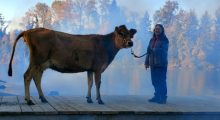Filmmaking
Filmmaking
-
Location Shooting and Independent Production: A History of Necessity and Innovation

In the 1910s, movie moguls built the major Hollywood studios to control every aspect of film production. Rather than succumbing to unpredictable weather and transporting an army of workers across the globe, they built massive sets, stages and large backlot settings like Western streets and jungles. Hundreds of employees churned out movies with near assembly-line efficiency. These studios created strong barriers to entry for independent filmmakers, who made do with inferior rental studio lots. However, a dramatic location, creatively captured, could rival any Hollywood construction. On location, low-budget and independent filmmakers sought production value on the cheap. Westerns proved to […]
-
The Low Down: Is Microbudget Production the Response to the Industry’s Devaluation of the Dramatic Feature Film?

There are conflicting opinions regarding the budget cutoff for the category commonly referred to as “microbudget filmmaking.” Sometimes referred to as “no-budget,” “ultra-low-budget” or “nano-budget,” the term refers to an increasingly popular level of filmmaking below “low-budget” that emerging filmmakers as well as, in some cases, veterans engage in. When Venice’s Biennale College Cinema was started eight years ago, the budgets of €150,000 (about $162,000) awarded to each filmmaker seemed low. And indeed, while makers of films—ambitious pictures such as The Fits, H., Memphis and This Is Not a Burial, It’s a Resurrection—produced through that program struggled with the budget […]
-
“A Cow At 8:00 AM is Different Than A Cow At 2:00 AM”: Animal Trainer Lauren Henry on First Cow

Kelly Reichardt peppers her 19th Century Oregon Territory with warm cakes and endearing fauna. Eve, the “first cow” in the territory, is a symbol of opportunity to everyone but its natives, the hinge of the film’s plot, a romantic proxy to its protagonist, “Cookie,” and one of animal trainer Lauren Henry’s best behaved cows. The secret to contriving “wild” and natural animal behavior in the preposterous habitat of the movie set? Patience. Putting the time in to normalize the set for the animal and any action he or she might have to perform in it. But Henry’s work goes beyond […]
-
S. Craig Zahler and the Art of the Podcast

“We have a solution to Hollywood’s ‘development hell’ which I am pleased to share with everyone.” This was how Dallas Sonnier, or at least his marketing department, announced the introduction of “the original audiostate,” the neologism Cinestate (Sonnier’s Dallas-based indie production company) coined to avoid the dread word “podcast.” Through marrying the “grandiosity of Hollywood films with the intimacy of audio,” the audiostate is meant to transform that most beloved of objects, the unproduced screenplay, into multi-platform pitchable content. Since Sonnier’s 2017 statement, only one audiostate has been produced: the same year’s The Narrow Caves, a story of eldritch horror, […]
-
Daniel Chew and Micaela Durand’s Negative Two Now Online at Le Cinema Club

“Our films navigate what it means to exist today – the frustrating intimacies and alienation, and how the internet is not only a self-affirming tool, but also connected to our jobs and livelihood,” write filmmakers Daniel Crew and Micaela Durand in introducing their short Negative Two at Le Cinema Club, where it streams online until this weekend. “Our economy demands for us to be constantly online and we wanted to portray that simultaneity.” Commissioned by The Shed and selected for last year’s International Film Festival Rotterdam, Negative Two, as described in the program notes, “focuses on Devin (Eric Lee), a […]
-
“VR Can Be So Many Things”: Diversion cinema Co-founder Camille Lopato on Distributing VR

Frequent visitors to major film festivals will have spent the last few years tracking the improvement not only of virtual and augmented reality pieces, but also of how they’re shown. Throughput has increased, displays and decorations gone from relatively slipshod to professional, and most recently entire groups of viewers have been accommodated simultaneously in group viewing sessions through synchronized headsets. In the meantime, commercial venues—some permanent, some pop-ups—have sprung up around the globe, offering VR games and films as part of a new wave of location-based entertainment (LBE). The Paris-based Diversion cinema is at the forefront of developments like these. […]
-
“Send the Actors to Set with Everything They Need For Their Bodies”: Costume Designer Keri Langerman Dresses The Photograph

After her mother passes away, Mae (Issa Rae) finds letters and a photograph left to her in a safety deposit box. The letters recall an unrequited romance between her mother, Christina Eames (Chante Adams), and a man Mae’s never heard of, Isaac Jefferson (Y’lan Noel). What got between them, mostly, was just space. Christina moved to New York to pursue the kind of career you can’t ambling clammy in the heat. Isaac stayed home. This is a timeless romantic dilemma. As The Photograph shows what happened between Christina and Isaac, the same dynamic recurs in the present between her daughter […]
-
“It is An Object That Should Not Belong to that World”: The Mole Agent‘s Maite Alberdi

Whether capturing or creating a world, the objects onscreen tell as much of a story as the people within it. Whether sourced or accidental, insert shot or background detail, what prop or piece of set decoration do you find particularly integral to your film? What story does it tell? In the detective’s office there is a poster of Al Pacino in Scarface on a dollar bill. The detective likes Tony Montana, but Scarface has nothing to do with him, nor with the subject of the documentary, and the mafia is not related to the references of cine noir which The Mole Agent addresses. Therefore, it is […]
-
“There Was So Much to Shoot in Such Little Time”: DP Matt Maio on La Leyenda Negra

In Compton, California, a teenage girl named Aleteia copes with being the new girl at school by immersing herself in underground activism. Aleteia grew up in the United States, but as an immigrant from El Salvador, she suddenly finds her protected status under attack. During this tumultuous time, Aleteia unexpectedly falls in favor with one of the most popular girls at school, Rosarito, and as their friendship blossoms, Aleteia finds it more important than ever to find a way to stay in her hometown. DP Matt Maio talks about the advantages of working with director Patricia Vidal Delgado and the […]
-
“Not Playing Any Moment Expressly for Laughs Without Emotion”: Editor Robert Grigsby Wilson on The 40-Year-Old Version

Radha Blank writes, directs and stars in The 40-Year-Old Version, about a woman named Radha who struggles with the stigma of being single and struggling with her art at the age of 40. After what seems like a barrage of rejections from theater companies, Radha finally feels reinvigorated when she revisits her long-forgotten love of rapping. She eventually feels torn when interest is finally shown for a play of hers when she is in the midst of working on a rap demo tape. Editor Robert Grigsby Wilson talks about his own love of hip-hop, his own professional trajectory as an […]










